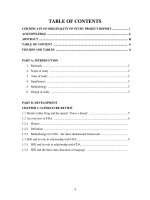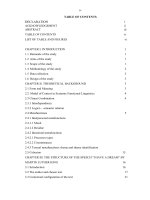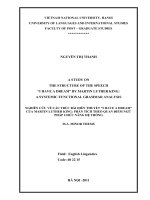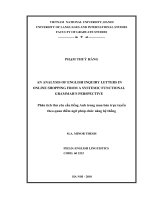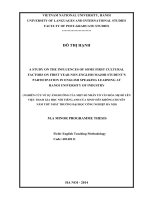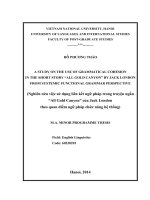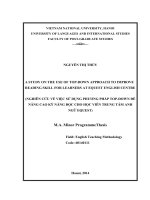A study on the structure of the speech “ I have a dream” by Martin Luther King A systemic functional grammar analysis
Bạn đang xem bản rút gọn của tài liệu. Xem và tải ngay bản đầy đủ của tài liệu tại đây (191.94 KB, 4 trang )
A study on the structure of the speech “ I have a
dream” by Martin Luther King : A systemic
functional grammar analysis
Nguyễn Thị Thanh
Trường Đại học Ngoại ngữ
Luận văn ThS. Chuyên ngành: English Linguistics; Mã số: 60 22 15
Người hướng dẫn: Nguyễn Thúy Hương, MA.
Năm bảo vệ: 2011
Abstract: This study applies Systemic Functional Grammar in order to investigate the
structure in the speech “I have a dream” by Martin Luther King. At first, there is an
overview of the Systemic Functional Grammar approach, additionally, the framework
developed by Halliday, will be used as the base for the study. Following that is the
Functional Grammar Analysis of the speech “I have a dream” by Martin Luther King.
Finally, some implications for applying Systemic Functional Grammar in language
teaching and learning are provided as well as the final conclusion of the study.
Keywords: Tiếng Anh; Ngữ pháp; Bài diễn thuyết
Content
CHAPTER I
INTRODUCTION
1. Rationale of the study
Language, no matter how it is analyzed and assessed, is still produced due to human needs.
Therefore, its structure and components are functional with respect to those needs (M.A.K
Halliday, 1994). This leads to the fact that no language item is separate, each piece of it is
evolved to the functions which are decided by humans in communication, and grammar is not an
exception.
However, it seems that the process of teaching and learning the language tends to make a clear
distinction between grammar and other linguistics areas, as in structuralism’s perspectives.
Functionalists, on the other hand, hold the belief that “Grammar should be seen as facilitating
communication in all modes, not as an isolated area of study” (G. Lock, 1996).
As having the experience of drilling with a number of grammar exercises in schooling as well as
being the teacher for many grammar classes, I am deeply interested in improving the language
proficiency along with the structure accuracy for my students. That is the reason why I have
developed a great attention to Functional Grammar (or FG for short). The further I am absorbed
in this linguistic aspect, the stronger my notion of its applications in language teaching and
learning becomes.
Hence, I decided to conduct a study on the structure and meaning of the speech “I have a
dream” by Martin Luther King - a systemic functional grammar analysis based on Halliday’s
functional grammar as the theoretical framework.
1.2 Aims of the study
In carrying out the research, the writer aims to:
Illustrate the key concepts in FG
Analyze the structure and meaning of the speech “ I have a dream” by Martin Luther
King
Suggest some further implications for language teaching and learning
1.3 Scope of the study
It would be impossible for the researcher to cover the issues of FG. However, some important
notions such as linguistic system, metafunctions and cohesion which are closely related to the
study will be examined in detail.
1.4 Methodology of the study
The structure and meaning of the speech will be focused in the study, therefore the
methodologies applied are:
Descriptive which is used for illustrating the crucial matters of FG
Analysis which is used for studying the speech
1.5 Data Collection
A various number of examples and illustrations have been extracted from functional grammar
works by well known linguistics such as M.A.K Halliday (1985/1994), Thompson (1994),
G.Lock (1996), Van. Hoang Van (2006)….
The content of the speech “I have a dream” is retrieved from the official and popular website
www.americanrhetoric.com .
1.6 Design of the study
There are four main chapters in this minor thesis
Chapter I: Introduction , gives an overview of the rationale, aims, scope, methodology
and design of the study
Chapter II: Theoretical Background, illustrates the theoretical background for the main
concepts in FG
Chapter III: The analysis of the speech “I have a dream”
Chapter IV: Conclusion summarizes the outcome of the research and suggests some
further implications for language teaching and learning.
References
1. Alexander, T. (2004). Basic Concepts of Discourse Analysis. Available : www.grin.com
2. Brown, G & G.Yule (1983). Discourse Analysis. Cambridge: CUP
3. Cambridge Advanced Learner’s Dictionary (2005). Cambridge: CUP
4. Collins English Dictionary (1979). HarperCollins
5. Halliday, M.A.K (1994) An Introduction to Functional Grammar. London: Edward
6. Halliday, M.A.K (2002) Linguistic Studies of Text and Discourse. London: Continuum.
7. Homer, W.B (1998) Rhetoric in the Classical Tradition. New York: St. Martin’s Press
8. Hoa, Nguyen (2000) An Introduction to Discourse Analysis. Hanoi National University
Publishing House
9. Lock, Graham (1996). Functional English Grammar. Cambridge: CUP
10. Nunan, D. (1993) Introducing Discourse Analysis. London: Penguin
11. Thompson, (1996) Introducing Functional Grammar. Oxford: Oxford University Press
12. Van, Hoang Van (2006) Introducing Discourse Analysis. Hanoi: Education Publishing
House
13. I Have a Dream, Martin Luther King, Jr.
Available: www.americanrhetoric.com/speeches/mlkihaveadream.htm
